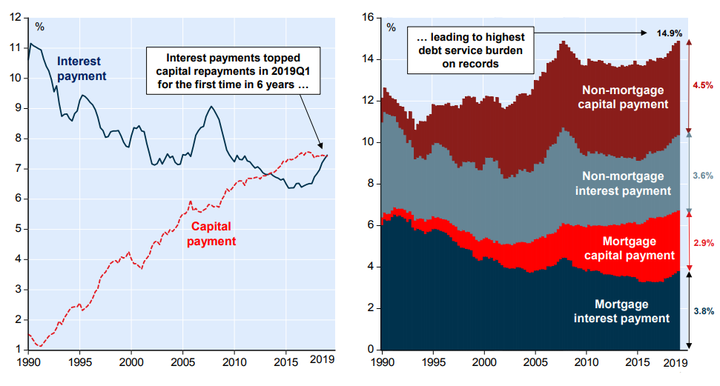
Canadians have taken on so much debt that monthly payments are eating up a record share of paycheques.
The typical Canadian spent 14.9 per cent of their disposable income making payments to cover debts in the first quarter of this year, according to an analysis of Statistics Canada data by National Bank of Canada.
That’s up from around 11 to 12 per cent in the 1990s, and just below 13 per cent in the years before 2017, when the Bank of Canada started hiking interest rates, pushing debt payments up.

National Bank senior economist Krishen Rangasamy sees a problem in this for businesses that rely directly on consumers.
“It means there’s fewer dollars in wallets to spend on other things, so that’s not good for consumption-spending growth,” he told HuffPost Canada by phone.
Watch: How much home can “peak millennials” afford in Canada? Story continues below.
With Canadians maxed out on their debts, the Bank of Canada’s interest rate hikes seem to have had more of an impact on borrowers than the Bank may have expected.
Consumer insolvencies were up by 9.3 per cent in April, compared to a year earlier, according to the Office of the Superintendent of Bankruptcy, rising to their highest level since the Great Recession.
And that’s despite the fact that Canada’s economy has been strong, wage growth has accelerated and unemployment is at record lows.
The heavy debt burden Canadians are carrying is one major reason why the Bank of Canada has put a halt to interest rate hikes this year, after raising its key lending rate five times between 2017 and 2018.
Rangasamy says the Bank, like other central banks around the world, is “stuck.”
On the one hand, it wants to end the era of very low interest rates, which have pushed up the price of housing and other assets that depend on debt. On the other hand, consumers have taken on so much debt paying for those things that raising interest rates too much now could “seriously hurt the economy,” Rangasamy said.
Canadians race to pay off debt
One positive aspect here is that households seem to be aware of their debt problem, and are taking advantage of the good economic times to pay down what they owe.
Repayment of capital (the non-interest part of debt) is near all-time highs in Canada, both for mortgages and non-mortgage debt, Rangasamy noted.
That’s “particularly encouraging with regards to stability of the housing market and hence financial system as a whole,” he wrote in a client note.
Rangasamy cited research from Mortgage Professionals Canada, which showed that 92 per cent of Canadian homeowners owe less than three-quarters of the value of their home.
This means that, in the event of a housing downturn, very few Canadians will end up “underwater” on their homes, owing more on their mortgage than their house is worth.